What and how to store carrots in the cellar in winter: a selection of the best ways
How to properly store carrots in the cellar in winter is a question that vegetable growers often face. There are many reasons why root crops rot: improper processing of plants, unprepared premises, non-compliance with optimal conditions.
An important factor during winter storage is choosing a variety with high keeping quality. We'll talk about these and other nuances further.
Varieties suitable for long-term storage
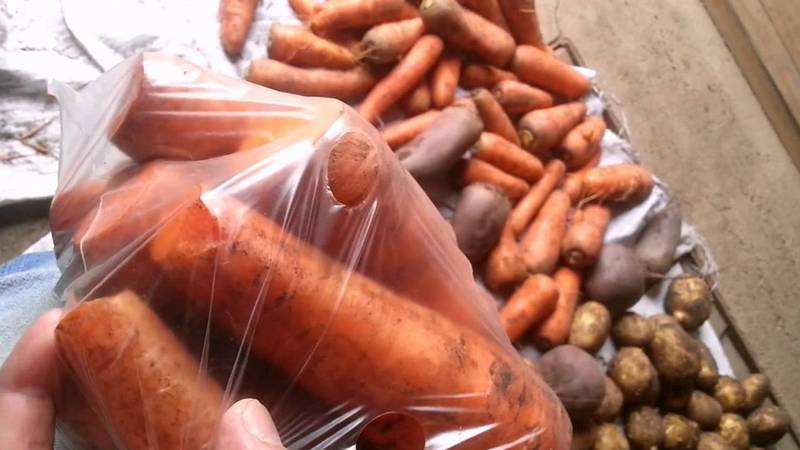
To preserve the harvest longer, mid-season and late varieties are planted. Important characteristics of culture:
- growing season - from 115 days;
- lack of predisposition to major cultural diseases;
- low risk of cracking;
- Suitable for any climate.
Nantes 4
It takes about 120 days for root crops about 20 cm long to ripen. If you plant the seeds of this variety in May, then the harvest is already harvested in September. If there is not enough time, carrots are left in the ground until October. Vegetables are stored until February. From 1 m2 they collect 5-6 kg.
Samson
Mid-season variety low maintenance, suitable for any soil and climate. Ripens 110–120 days from the first shoots, stored until May of next year. The average length of carrots is more than 20 cm, weight - 125–150 g. Productivity is high - up to 762 c/ha.
Chance
Mid-season variety, 110 days after planting produces juicy root crops of marketable appearance. Productivity - 5 kg/m2. When grown, it requires sufficient light, loose soil with a high percentage of humus. Vegetables are stored until March.
Queen of Autumn
Late variety ripens 130 days after sowing. With proper care and fertilization, the root crops reach 25 cm in length, 85–230 g. Such carrots can be stored until the next harvest without loss of taste and marketable qualities. Productivity - 265–576 c/ha.
Dolyanka
Late Dolyanka preserves the marketable appearance and taste of carrots until spring. Vegetables ripen 140–150 days after sowing. Root crops grow 15–22 cm long, weighing 95–145 g. The marketable yield of the variety is 243–372 c/ha.
Karotan
Late-ripening Carotan grows best in well-lit, loose soil. The harvest is stored until the next season, the vegetables grow at least 25 cm long. The time from the first shoots to maturity is 135–150 days. Productivity - up to 405 c/ha.
Vita Longa
The variety is resistant to black and gray rot and has high transportability. It takes up to 160 days for carrots to fully ripen, and they are stored until the new season. Root crops grow up to 30 cm in length, weighing up to 130 g. Productivity is 200–490 c/ha.
How to prepare carrots
In order for root vegetables to retain their presentation and taste, it is important to harvest on time. Specific dates for each variety or hybrid are indicated on the seed bag. Root vegetables removed earlier will be unripe and unsweetened.
Attention! If the exact time for harvesting carrots is unknown, they are guided by the color of their tops. Vegetables are ripe when the lower leaves turn yellow.
The harvested crop is sorted. Overgrown, underripe or damaged specimens are not suitable for long-term storage. To keep carrots juicy and crisp for a long time, do not water them the day before digging.
Vegetable tops are trimmed, ventilate them under a canopy or dry them in the sun for about three hours. Maintain for 7–10 days at +1…+14°C to identify defects.
How to trim the tops correctly
They do this in stages:
- The tops are cut to the head of the vegetable.
- After drying, the end of the carrot is cut off by 1 cm, completely removing the growth point.
Use a sharp knife to ensure an even cut. The resulting crust will retain moisture and beneficial properties of the root vegetable.
Preparing the cellar
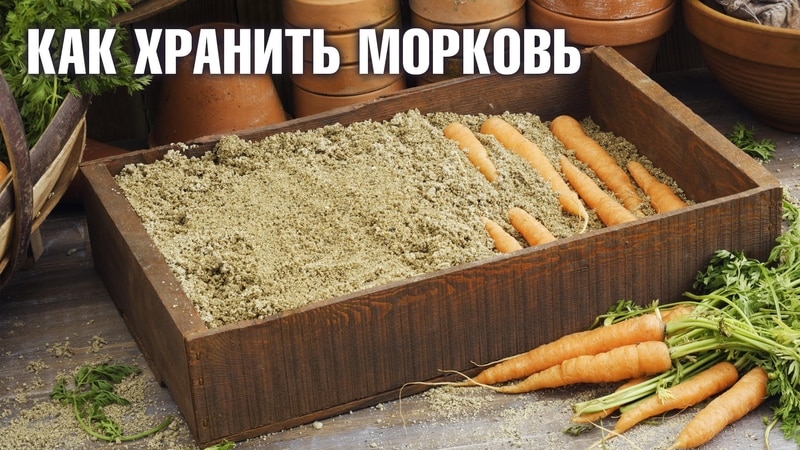
A properly prepared cellar will preserve the quality of the harvest longer. To do this, several procedures are carried out:
- Ventilation: the room should be cool, free of foreign odors.
- Disinfection: basement walls are sprayed with a 2% bleach solution.
- Whitewashing the walls.
Optimal conditions for storing carrots:
- standard temperature - from 0 to +4°C (at high values the carrots will begin to sprout and wither, at low values they will freeze, and when they thaw they will rot);
- air humidity - 60%.
Selection of containers
Before placing carrots in the cellar, determine the container in which it will be stored.
Enameled pans
This option is suitable for those who do not have much harvest. After assembly, the carrots are washed, their tops are trimmed, and dried. Root vegetables are placed in a pan close to each other, in a vertical position, covered with a napkin on top, and kept under the lid.
Boxes
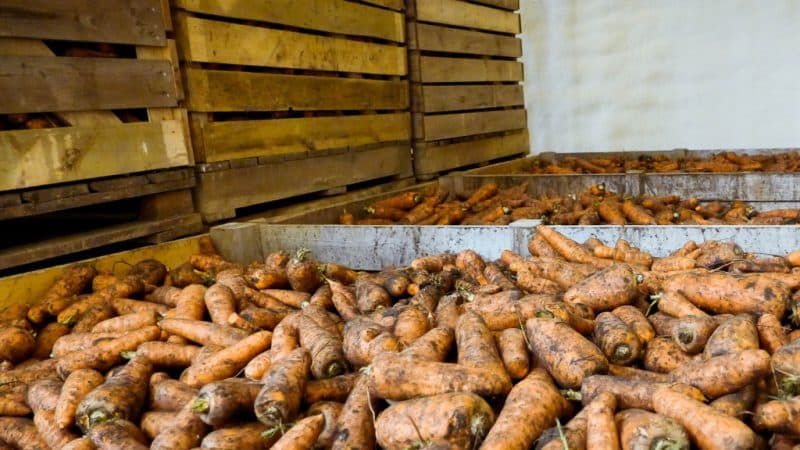
Carrots are placed in boxes in small batches, about 20 kg each. The container is closed and placed on the floor without touching the walls.
Some gardeners keep the boxes on stands because they sometimes get wet on the floor, which causes the vegetables to sprout.
Bags
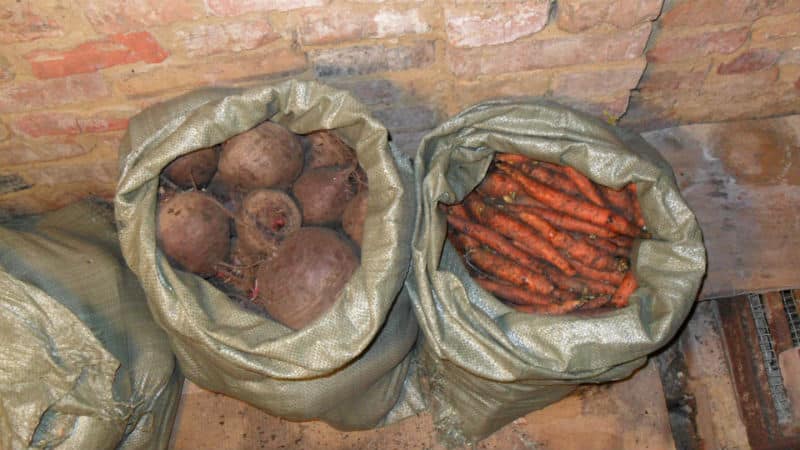
The containers are left open, since otherwise the carbon dioxide released by the root crops will exceed the oxygen concentration, which will lead to damage to the crop. Holes are made in the tied bags for ventilation.
Good to know. A less popular option is plastic bags.They are left open in the cellar or at home so that the vegetables do not wilt.
Filler selection
An important role in the long-term preservation of carrots is played by the material with which the container is filled.
Sand
Take dry and clean sand, pour it on the floor in the cellar, about 3 cm, then lay a layer of carrots, again a layer of sand, vegetables, and so on until the end. This structure is built up to 75 cm in height.
Husk
Dry onion scales are a universal antiseptic, thanks to which carrots will retain their presentation and will not rot. Vegetables are placed in bags and peels are added.
Mix everything carefully so that each root vegetable is in the husk.
Clay
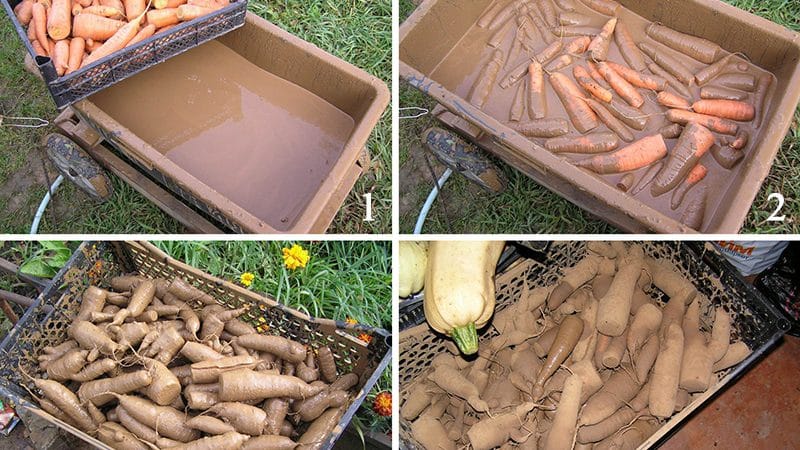
Quite an unusual and one of the best ways to store carrots: for this, clay is diluted with water to a mushy state. Each vegetable is dipped into the resulting mixture and left to dry.
Ready root vegetables are placed in boxes or boxes and put in a cool place.
forest moss
The principle of laying is similar to storage in sand. To begin with, unwashed and dried root vegetables are left in a cool place for exactly one day, and after that they are placed in boxes, alternating layers of carrots and moss.
Chalk
This material reduces the risk of bacterial growth. Carrots are placed vertically in the box, close to each other. Mix powdered chalk and wet sand and cover the vegetables with them.
Sawdust
Sawdust contains phytoncides that destroy fungi and bacteria and prevent rotting of vegetables. In this case, the carrots are laid in layers: the filler is alternated with root vegetables. Pine sawdust is well suited for this.
Shelf life
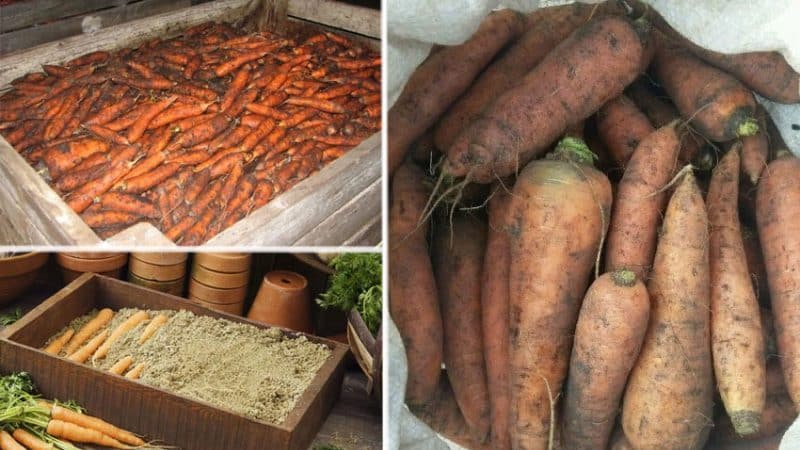
Under optimal conditions in the cellar, carrots do not lose their quality for 4 to 12 months.
The specific shelf life depends on the selected variety, container and filler:
- in clay - 12 months;
- in sand - 7–9 months;
- in sawdust - 1 year;
- in boxes - 4–7 months;
- in bags and sacks - 2-3 months.
Reviews
Summer residents share their experience of growing carrots and storing them on online forums. Let us share some comments with you.
Olga, Chelyabinsk: «My favorite variety is Queen of Autumn. This is the third year I’ve been planting only this plant, and it has never let me down. Carrots always grow large, bright orange and full of flavor. It's easy to care for. Before sowing, I loosen the soil well. In addition to applying fertilizers during cultivation, I spray the crop itself against carrot flies and other pests. This way it lasts longer.”
Irina, Izhevsk: “Last year I planted the Dolyanka variety - the carrots grew quite large and tasty. I decided to try a new way of storing in bags. I left them open in the basement. As a result, I was disappointed, since the vegetables lasted only 1.5 months, most of them had to be thrown away. This year I will keep the harvest in the sand.”
Conclusion
To preserve the carrot harvest in the cellar throughout the winter, it is important to create and maintain optimal conditions. Mid-season or late varieties are planted. Choose a room that is clean, well ventilated and cool.
Boxes are good containers - they are filled with sawdust, sand, and moss. Follow the basic recommendations, and then you can enjoy tasty and healthy vegetables for a long time.